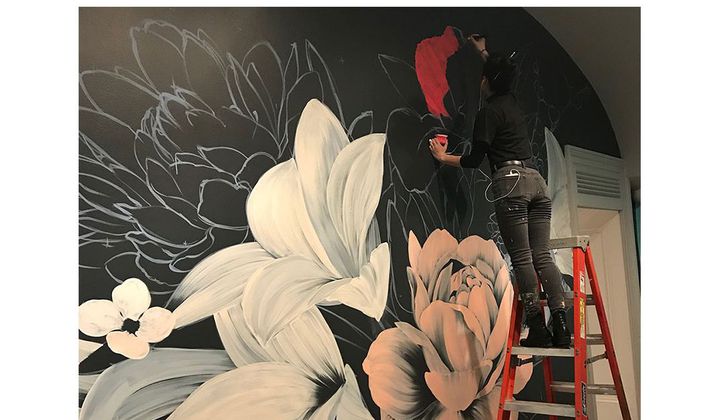ART NEWS
Interview with Muralist Louise Jones | Smithsonian Voices | Archives of American Art
[ad_1]
Smithsonian Voices Archives of American Art
Interview with Muralist Louise Jones
For the Archives of American Art exhibition Bloom: Flowers from the Archives of American Art, curator Mary Savig invited the artist Louise Jones (née Chen) to create a mural for the Lawrence A. Fleischman Gallery space. Jones, who goes by the artist name Ouizi, has gathered admirers and accolades for her luminous murals, which are often flower-themed. The mural she created for the Archives is titled Adaptation Nocturne and it incorporates roses, irises, clover, and other flowers, along with inspiration drawn from Orchids: Amazing Adaptations on view through April 27 in the Kogod Courtyard, adjoining the exhibition space.
Jones was born and raised in Los Angeles and studied drawing and printmaking at the University of California, Santa Cruz. She moved to Detroit in 2014 and has made over fifty murals—many of which are in the city; across the country in North Carolina, New York, Virginia, Arkansas, Illinois, Hawaii, and other places; and abroad in China and New Zealand. A gifted multitasker, Jones answered some questions about her process and influences, all while deftly painting the clovers on the bottom left corner of the mural in the gallery.
—Rihoko Ueno for the Archives of American Art
This interview has been edited for length and clarity.
How did you choose Ouizi as your artist name?
The way that I spell it, I discovered it because I found this coffee table on the side of the road that was the perfect size for an oversize Ouija board. I decided it would be cute to write my name at the top, except instead of the way that you spell Ouija, it would say “Ouizi.” There are other reasons why I like the name Ouizi: the way that it’s spelled is half French, half Chinese. The first half is “oui” or “yes” in French and the second half is “zi” which can mean “little” or “seed.” I’m not fluent in Chinese, but my given name, Louise Chen, is French [for the first name] and Chinese [for the last name].
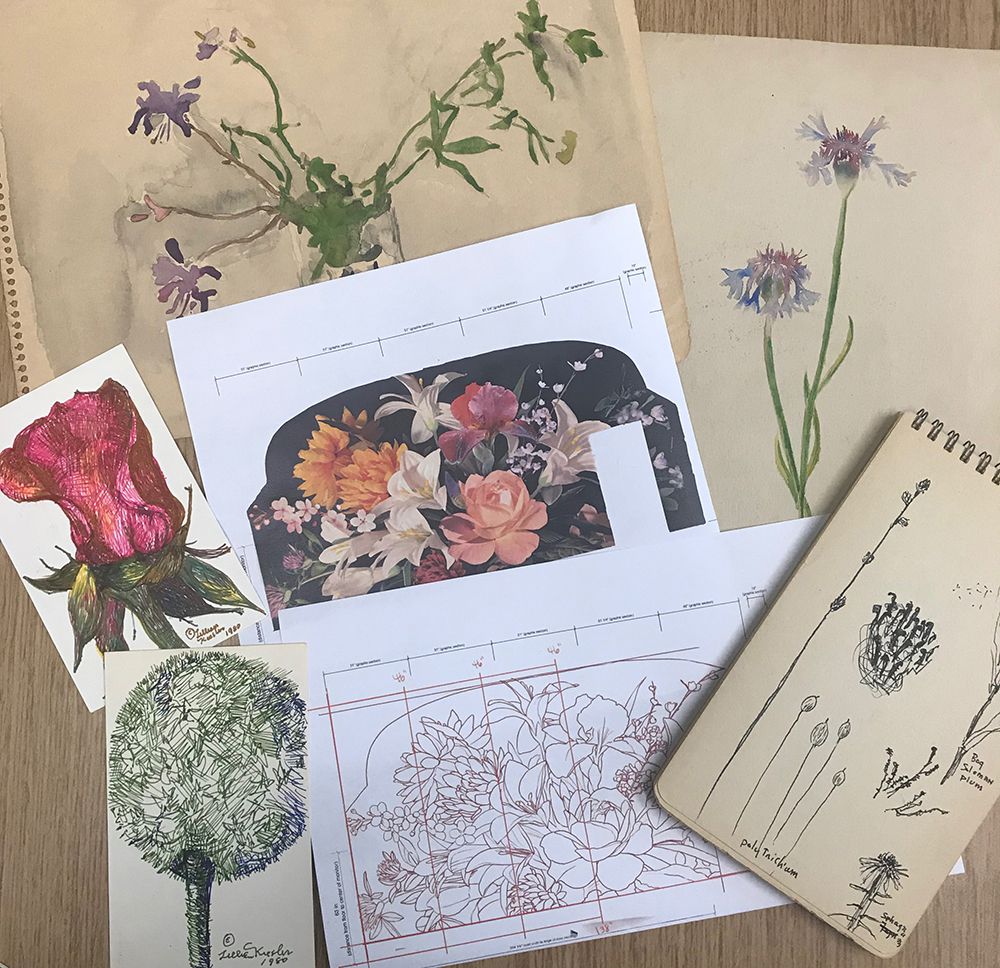
Schematic drawings of the mural next to documents from the Archives that Ouizi used for inspiration. (Archives of American Art)
Our curator Mary Savig approached you about creating a mural for our gardens exhibit in conjunction with the orchid show. Did Mary show you images of materials that would be in our exhibit? Could you tell me a little about your process for creating this mural?
She started by showing me the digital files [of documents from the exhibition]. I looked through those and drew the inspiration for the flowers that I would include. She requested that I paint a bouquet that’s rooted, that’s coming from the bottom. In order to make the bouquet I took a bunch of silk flowers and set it in front of a black backdrop and took the photo, and I manipulated the photo with elements that were part of the exhibit, like irises and cherry blossoms, items that were not in my silk bouquet. So it’s half real, half imagined, half referencing the orchids that were outside. I included those as soon as I got here, so it’s evolved over time.
And you talked to the orchid specialist?
I did. I was asking if there were certain orchids on display that were pollinated by moths because I really enjoy moths and this particular piece really feels like it exudes the nighttime, so I wanted to include a moth. Unfortunately, none of them are moth pollinated; they’re all bee pollinated, so I might include a bee.
Do you incorporate “flower language” or the idea that certain flowers hold meaning into your murals?
Definitely. This one sort of has a little bit of that but it’s more so my interpretation. It’s a mix because sometimes I want to say something particular with a mural, so every flower will have a specific part of a story. For this one, it’s a combination of wildflowers and classical flowers like the rose and I wanted to combine all of those because I wanted to show that a bouquet can be made up of not just cultivated flowers. It’s also cool to highlight plants in general that grow [native to the] area. All of the photos from the Archives that are in the exhibit—it’s a range, wildflowers and all. I love that.
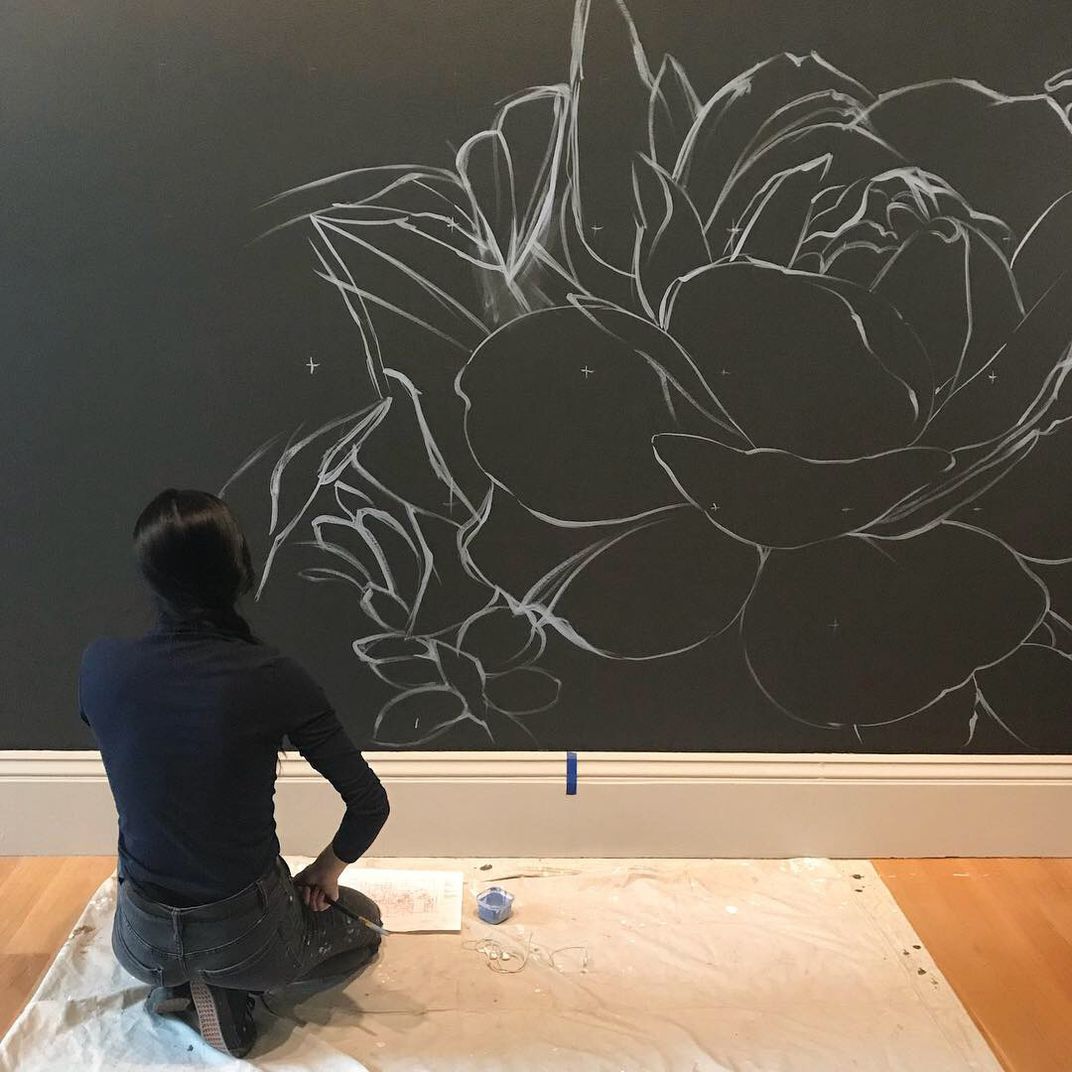
I’ve read that chinoiserie is among your influences and I can see that in the stylization of the flowers in some of your murals, especially those with the thicker black outlining. What other influences and inspiration do you draw from in your daily art practice?
I really like to look at old classical Chinese watercolor paintings but also ukiyo-e Japanese woodblock printing, specifically the ones that represent nature—flowers and birds.
You were very involved in LA bike culture after graduating from UC Santa Cruz. Could you tell me a little more about that?
You’ve really done your research. That shaped me as a person so much! That was one of the reasons why I also started making structures and trying to expand my artistic practice. I was thinking about play and building my life from scratch and all of those wonderful things. Basically, I met this group of people in LA while I was in school at Santa Cruz and I fell in love with the community of it and the way that they used the public space in LA. We would go on bike rides starting at 9 [at night] and ride our bikes until 3 or 4 in the morning, but every few miles we would stop at a parking structure or underneath the freeway or in the tunnels of LA, and we’d bring big boom boxes and blast music and have a party and just be wild. We could create our own fun. We had the most diverse group of people. There were people in their sixties, there were kids—maybe not even eighteen yet. We had this big happy family.
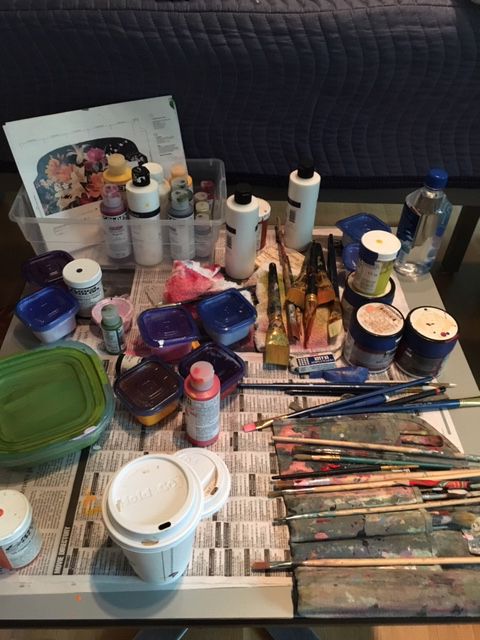
What other positions have you held before becoming a full-time artist?
I definitely was not a full-time artist right out of college. It was really hard for me to find work in LA when I moved back from Santa Cruz. Most of the work I ended up getting was in the film industry, random set design. That’s where I honed a lot of my building skills. I also worked for an art store as their resident muralist because they had these great floor to ceiling windows that the managers wanted to change out with murals every month. There were, I want to say, six 4’ x 8’ plywood panels that she would want me to paint both sides every month. That’s how I started to paint really big, really fast. I did some installations for [other artists], mostly building out structures and doing assistant work.
I was selling my work here and there a little bit out of school. I had my first real show with Giant Robot Gallery in LA and sold 80% of the work in the show, but after that it sort of dried up until I moved to Detroit. . . . I’ve always had my different hustles and side gigs and figured out how to make a little bit of money off of my art, but never a livable wage until the last four years.
As a mural artist, you get reactions right away from people. People were coming into the exhibition space earlier to see your mural and that immediate responsiveness must be gratifying.
Yeah, I understand that it’s really compelling to look at, but I also want people to try to talk to me about what they see aside from the size. I think that maybe that’s coming. People are still [getting] used to seeing these large paintings, but more of them are popping up, so I think that eventually people are going to feel more comfortable with the size and be like what’s the subject matter. People are just like, “Wow, street art!” but this is not street art, it’s not graffiti, it’s a mural.
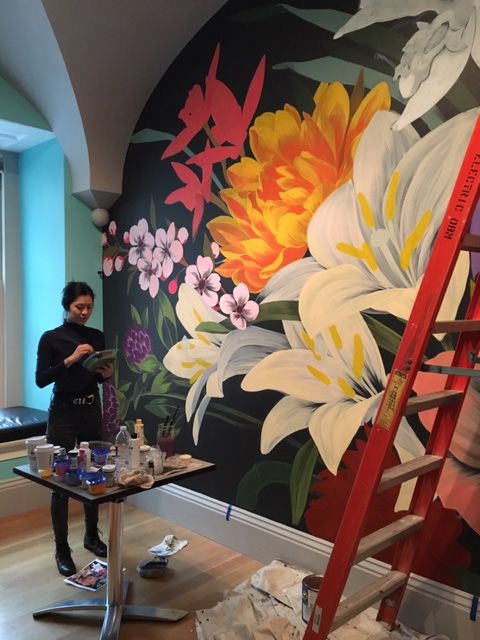
[Jones is Chinese American and her parents immigrated from Shanghai, China.] I know that with Asian American parents, like mine, you can encounter a lot of pressure to pursue more conventional paths. What does your family think of your career as an artist?
My parents have always been really supportive. They trusted that I knew what I was doing and they wanted me to see it through, so they never pressured me hard to do other things. It certainly wasn’t easy because my lifestyle choices were very different from theirs. I figured out how to live off of very little and that didn’t look to them like success. I was really happy and I lived in a house with eighteen other people in LA, in a warehouse, and it was the best time of my life. Everything was great, but when they saw that at that time, they were so sad. They were not happy, but they accepted me. That was when I was twenty-two or twenty-three, but now they couldn’t be happier and they are so proud, but they’ve always been very accepting, so I’m lucky.
You created a triptych of murals titled “Golden Heirlooms” in Shanghai, China, which you dedicated to your family. How did that project come about?
My family has a coat making business there. They make these beautiful wool coats and they sell them to designers, mid to high-end brands. So they have this factory there and when I went back that time, I asked them if they could help me find a wall to paint and they were like, “Why don’t you paint our wall? It’ll be great, we’ll help you.” Everybody pitched in. It was the first time I had gone back that I was really pursuing murals as a career and started with this formula of anywhere you go, paint a mural. So I went to Mexico and I found a café they wanted me to paint a mural in. Wherever I can put my hands on, I paint.
Circling back to Detroit, I read about the murals you created with other artists to raise awareness of tax foreclosures of homes in Detroit and about other projects to reduce graffiti around the city by increasing murals. Does a lot of your art have this activist component? Is that important to you?
I have mixed feelings about that because it’s great to use your art to promote anything that is humanitarian. If you have an audience you should use it for good, but I also feel like it’s a very dangerous thing to have that sort of influence and it’s a fine line between promoting your brand and your political ideas. And I don’t feel that the message I’m trying to convey most of the time is political, it’s universal. I think the most important thing that I’m trying to convey with my work generally is an appreciation of nature and universal beauty and universal harmony. I guess you could call it cliché or digestible but I would rather connect with as many people as possible, than isolate people or exclude people.
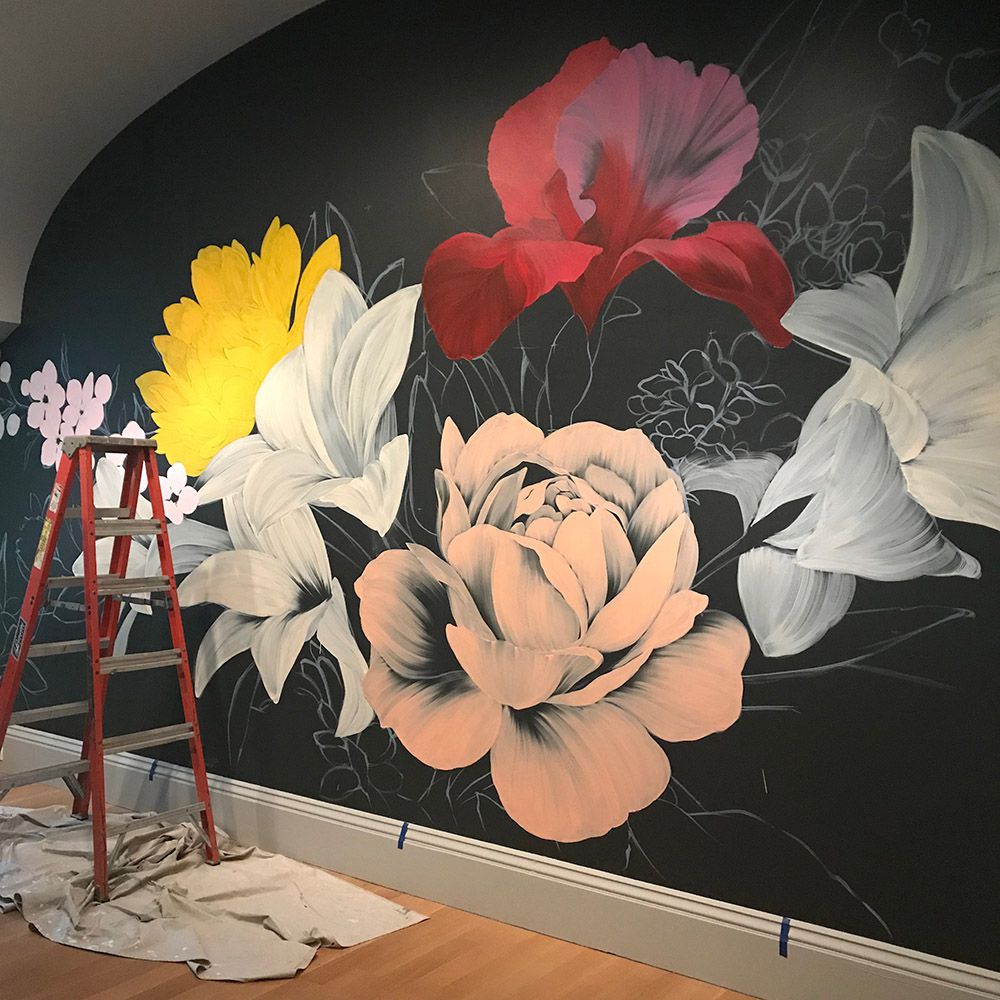
Do you have a large community of artists in Detroit?
Yeah, I do. There’s a lot of incredible people working in Detroit. In my immediate friend group I only have a few full-time working artists, but definitely a robust group. In the city at large, there are so many great artists that I have connected with and I can call upon if ever needed. Detroit is so diverse and fascinating. I want to remain there for the rest of my life.
You have a robust following on Instagram—over thirty thousand followers. Has social media largely been an asset to you as an artist? How do you feel it has impacted your work?
It’s been a huge benefit to me in terms of getting my work out there. The whole public art thing works really well with social media because people will take photos in front of my work and they’ll post it, so it’s like a full cycle. If your work is mostly in galleries, I think it’s a little harder to use social media because you don’t have the same connectivity with the public, with your work in real life. With murals it’s in real life x 2.
You mentioned in an earlier chat that you’re currently booked through next year. How do you choose your projects?
I have my personal vetting and it’s very particular and changes all the time. Every day I get emails and every day my career trajectory changes. If it’s a different city, I’m probably going to say yes, and if it’s a different country, I’m definitely going to say yes!
Any future projects you are especially excited about?
I just got off the phone with a lady who is in Knoxville, Tennessee, and she has a building. . . It’s some television building, but it’s a ten-story building and it’s tall and skinny, so those are my favorite types of walls. They’re like mini-skyscrapers and I’m excited to paint that, it’s all stand alone, so just the view of that is going to be incredible from every vantage point.
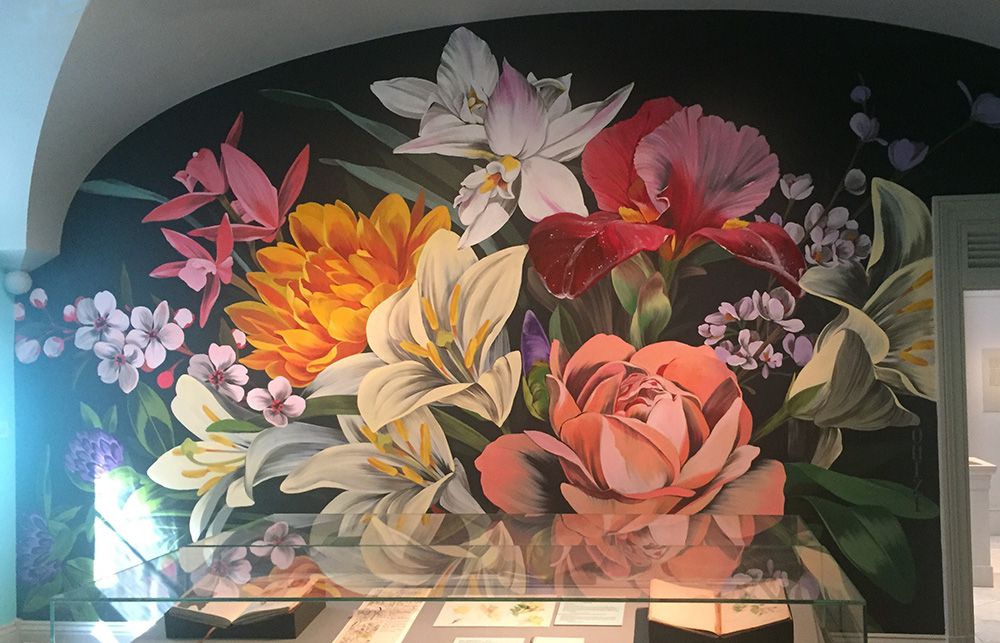
Are there particular flowers that you find challenging to draw and are there flowers that you are consistently drawn to?
I find it difficult to draw roses for some reason. It’s weird, I don’t know why. The funny thing is that there are so many interpretations of how they are painted in tattoos, in paintings, all over. For me, the hard part is finding my own way to paint them. I think that’s how I want to paint in general. I want to bring my own mark to it. That’s why roses are hard because if you don’t paint them how they look, then they don’t look right. But I painted one here and I made it look different from what I normally paint like so, I don’t know, I kind of like it.
Otherwise, I really like painting peonies and chrysanthemums, they’re great and orchids are really fun because they’re challenging. You really have to make them true to life if you want to make them look like orchids but there’s also a way to paint them in a calligraphy style, like Chinese watercolor, where you just paint five strokes and there’s an orchid. It’s incredible.
The exhibition Bloom: Flowers in the Archives of American Art is on view through October 6, 2019 in the Lawrence A. Fleischman Gallery at the Donald W. Reynolds Center for American Art and Portraiture (8th and F Streets NW, Washington, DC). Admission is free.
This interview originally appeared on the Archives of American Art Blog.
[ad_2]
Source link



